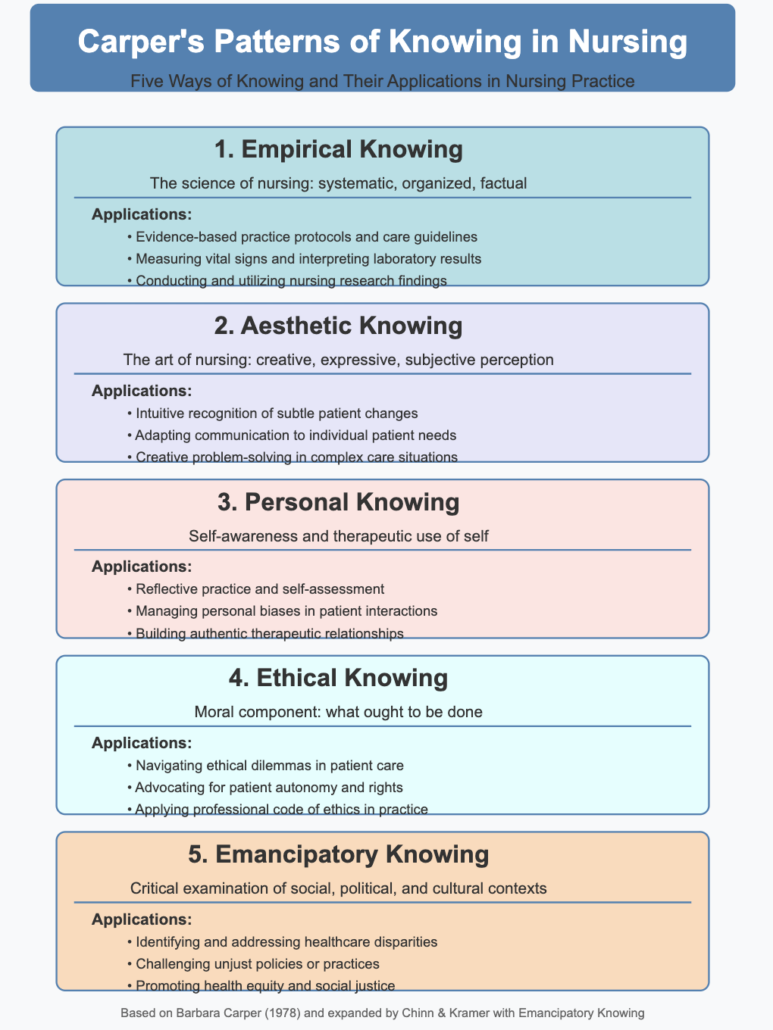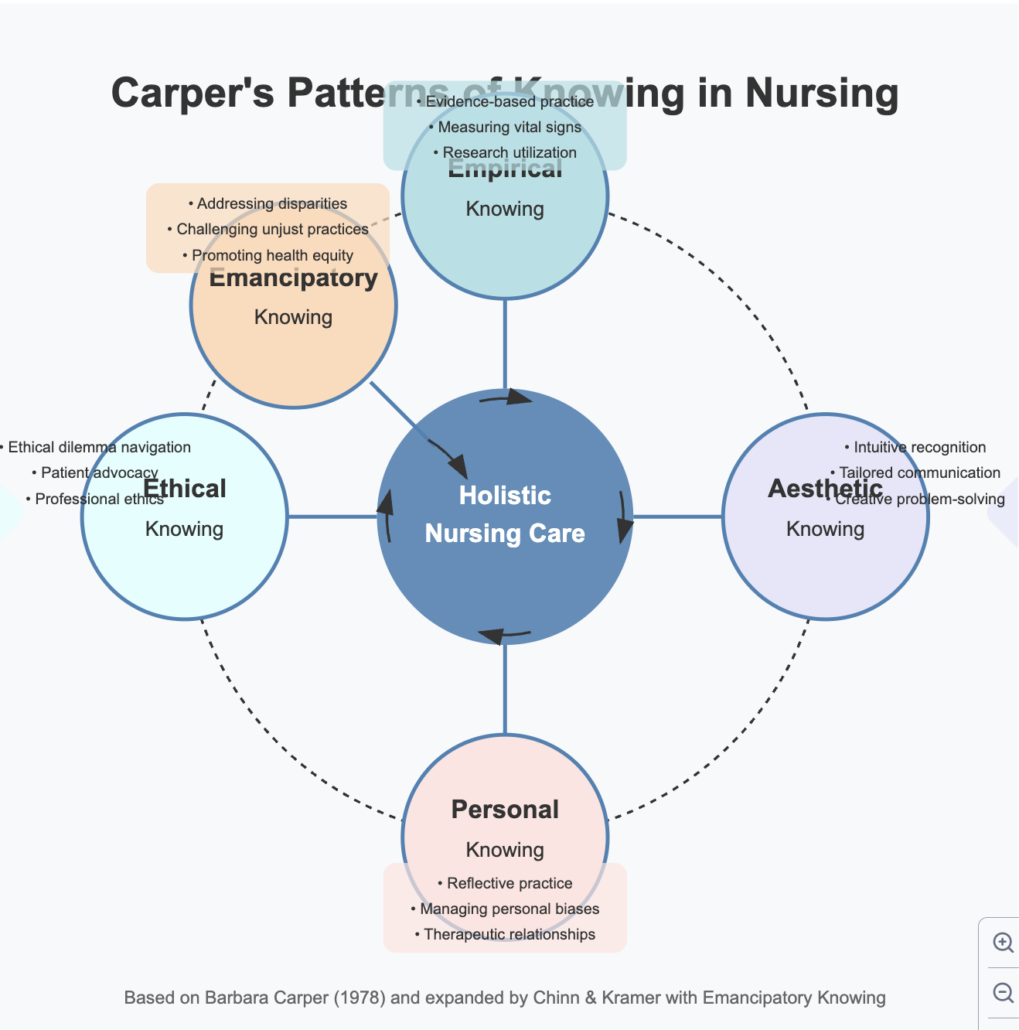5 Ways of Knowing Nursing
Knowledge is an integral element of human development, as it results from a comprehensive understanding of diverse concepts and repeated experiences in a specific setting. Nurses derive their knowledge from academic learning and nursing practice. Carper’s patterns of knowing in nursing include 5 ways of knowing nursing: empirical knowing, ethical knowing, personal knowledge, aesthetics, and Social-political knowing.
Carper’s 5 Ways of Knowing Nursing Practice: how they can be applied in nursing practice

Empirical Knowledge
Empirical knowledge is factual and descriptive. It offers the basis for nurses’ theoretical explanations of their environment.
Empirical knowledge is drawn from nursing science in which reality is perceived as something that the observer can measure, verify, and describe. Empirical knowledge examples include maternal mortality rates and cancer severity in specific environments, and it seeks to answer the questions of what this is, and how can it be explained.
Empiric knowing is the core of nursing education, and nurses rely on facts and descriptions from empirical research (Chinn & Kramer, 2015).
Ethical Knowing
However, certain aspects of the nursing environment, such as comforting the sick, feeding them, and educating patients, are not empirical. Ethical knowing is based on what is right and moral. Nurses follow ethical codes of conduct in their daily practice.
Ethics involves making moral decisions on what is right and wrong and being accountable for those choices (Chinn & Kramer, 2015). Ethical reasoning and moral knowledge are applied to every aspect of patient care. For instance, we may have a case where a patient does not want to eat and asks for the nurse to end his life. Despite patient anonymity, the nurse is expected to solve the issue through ethical reasoning.
Personal Knowing
Personal knowing revolves around reflection and responses that bolster nurses’ understanding of their environment. Carper describes personal knowledge as the approach of the nurse to develop a personal relationship with the patient. According to Carper, personal knowing involves understanding of the self and knowing another human being as a person, not as an object. Personal knowing develops through experience, increased personal interaction, and instinctive reflexes or judgements.
Personal knowing is complex to teach but very fundamental in comprehending an individual’s perceptions of health and wellness (Chinn & Kramer, 2015).
Aesthetics
Esthetic knowing is also described as the art of nursing, and it involves visible actions of nurses’ understanding of the patient’s needs. Esthetics is empathy and being able to experience and internalize another person’s feelings.
Experience is also crucial in aesthetic knowing since it strengthens nurses’ understanding of different caring patterns to care for patients uniquely (Chinn & Kramer, 2015).
Social-political Knowing
The fifth pattern is social-political knowing of the person and the personal interaction. The two levels of social-political knowing include the context of the person, “the nurse and the patient,” and the professional context.
Social-political knowing offers a broad understanding of class and power structures, and how they generate sexism, racism, ageism, and classism, impacting health and illness. This knowledge helps nurses articulate societal structures such as poverty, unemployment, isolation, and alienation.
Nurses should critique the implications of these structures on the health of an individual and society (Persegona, Rocha, Lenardt & Zagonel, 2009).

Jean Watson’s views on patterns of knowledge
Watson describes empirical knowledge as the science that requires knowledge to be verifiable and have factual descriptions and explanations. Empirics need to have objective and or subjective collections of data, such as scientific data.
The aesthetic knowing (the art of nursing), according to Watson, is what is considered fundamental in the understanding of a patient’s behavior and feeling. Nurses need to develop interpersonal relationships and interactions with the patients to strengthen comprehension (Watson & Woodward, 2010).
Through these relationships, nurses can accept the patients as they are and do what they need in the “who” and “what.” The transpersonal relationship makes nurses’ actions visible.
Watson views ethical knowing as what is perceived as good for the patient and involves an explanation of moral and non-moral obligations and the outcomes of ethical reasoning and decision making. Ethical knowing includes nurses’ ethical code of conduct, standards, and philosophies.
Personal knowing develops through interpersonal interactions that exist between the patient and the nurse. These interactions help nurses reflect and build upon the experience to better understand and care for their patients (Watson & Woodward, 2010). The interpersonal relationships of the nursing process express the quality of care.
Patterns of Knowledge that are more evident (or easier to apply) in Watson’s theory of human caring
Esthetic knowing, personal knowing, and ethical knowing are more evident and easily applicable in Watson’s theory. Watson provides broader descriptions of authentic presence, equanimity, love, and kindness. Watson’s theory principles enable the human being to develop deep belief and spiritual growth and flow within the body, mind, and spirit. This development helps nurses go beyond their ego to provide a physical and spiritual care and healing environment. Esthetic knowing, personal knowing, and ethical knowing can only be emulated through Watson’s human care principles (Cowling, Smith & Watson, 2008).
Empirical knowing is challenging to apply in Watson’s theory since some nursing practice aspects are not empirical. For instance, a nurse cannot use empirical knowing to comfort or feed a patient. The nurse needs to apply ethical, personal, and aesthetic knowledge to develop a relationship that helps understand the patient’s behavior.
Another example would be a nurse dealing with a patient who cannot communicate or express themselves. It is easy to understand the patient’s needs through personal knowledge, whether it is the need to use a toilet, adjust the sleeping conditions, hunger, room conditions, pain, or companionship.
Ethical, aesthetic, and personal knowledge helps understand the art of human caring and nurses apply necessary remedies and respond accordingly to patients’ needs.
